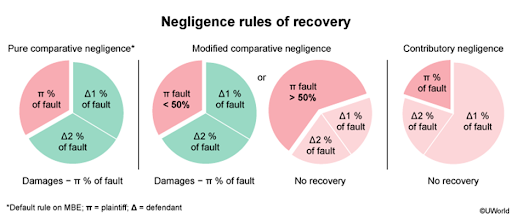What happens if you prevail on a negligence claim but are found partially responsible for your harm? Cue the quintessential lawyer answer: it depends!
Most jurisdictions determine the amount of damages that a plaintiff can recover by comparing the plaintiff’s fault to that of the defendant(s). This is called “comparative negligence,” which may be pure or modified to a middle-ground approach. Other jurisdictions take a harsher stance and hold that the plaintiff cannot recover any damages if the plaintiff contributed to his/her harm. This is called “contributory negligence.” These three rules of recovery are summarized below:
- Pure comparative negligence (default rule on the MBE®) – recovery is reduced by the plaintiff’s percentage of fault
- Modified comparative negligence – the same as pure comparative negligence, except that recovery is barred if the plaintiff’s fault exceeds 50%
- Contributory negligence – recovery is barred if the plaintiff shares any percentage of the fault, no matter how small (even 1%)
Remember to always apply pure comparative negligence unless the facts tell you otherwise! Here’s a simple illustration that will help you remember these concepts:

You can use this tip when answering practice questions in the UWorld MBE® QBank.




